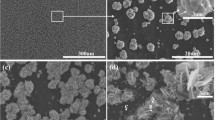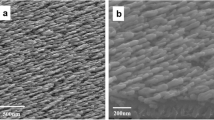Abstract
Surface-enhanced Raman scattering (SERS) is widely employed because it offers quick, microscopic, and traceless detection. This study used high-voltage and low-voltage ultrasonic oscillation to embed gold-silver nanoparticles (Au-Ag NPs) into the pores of chemically modified ultrathin anodic alumina (AAO) films, resulting in a highly sensitive three-dimensional SERS substrate. We improved the substrate’s stability and Raman activity by adjusting the particle alloy ratio. For the substrate in this alloy ratio, the Raman signal of probe molecules (Rh6G) adsorbed on the substrate surface is enhanced. the enhancement factor (EF) was as high as 1.40 × 107, the relative standard deviation (RSD) of 10.6%, and the concentration of Rh6G shows a linear relationship with Raman intensity, with a linear correlation coefficient of 0.961. In addition, we evaluated the substrate’s detection effect on thiram molecules. It has been proven that this structure has good practicality and high sensitivity as a Raman enhanced substrate.





Similar content being viewed by others
Data Availability
Not applicable.
References
Ding S, Yi J, Li J, Ren B, Wu D, Panneerselvam R, Tian Z (2016) Nanostructure-based plasmon-enhanced Raman spectroscopy for surface analysis of materials. Nat Rev Mater 1:1–16. https://doi.org/10.1038/natrevmats.2016.21
Dong J, Zhao X, Cao E, Han Q, Liu L, Zhang W, Gao W, Shi J, Zheng Z, Han D, Sun M (2020) Flexible and transparent Au nanoparticle/graphene/Au nanoparticle ‘sandwich’ substrate for surface-enhanced Raman scattering. M T Nano 9:100067. https://doi.org/10.1016/j.mtnano.2019.100067
Hutter E, Fendler JH (2004) Exploitation of localized surface plasmon resonance. Adv Mater 16:1685–1706. https://doi.org/10.1002/adma.200400271
Zhang C, Li Z, Qiu S, Lu W, Shao M, Ji C, Wang G, Zhao X, Yu J, Li Z (2022) Highly ordered arrays of hat-shaped hierarchical nanostructures with different curvatures for sensitive SERS and plasmon-driven catalysis. Nanophotonics 11:33–44. https://doi.org/10.1515/nanoph-2021-0476
Cao Y, Sun M (2022) Tip-enhanced Raman spectroscopy. Rev Phy 8:100067. https://doi.org/10.1016/j.revip.2022.100067
Dong J, Zhou W, Yang C, Wu H, Han Q, Zhang C, Gao W, Yan X, Sun M (2023) Preparation of a three-dimensional composite structure based on a periodic Au@Ag core–shell nanocube with ultrasensitive surface-enhanced Raman scattering for rapid detection. ACS Appl Mater Interfaces 15(23):28840–28848. https://doi.org/10.1021/acsami.3c05488
Dai Z G, Xiao X H, Wu W, Zhang Y, Liao L, Guo S, Ying J, Shan C, Sun M, Jiang C (2015) Plasmon-driven reaction controlled by the number of graphene layers and localized surface plasmon distribution during optical excitation. Light Sci Appl 4:e342. https://doi.org/10.1038/lsa.2015.115
Lin X, Fang G, Liu Y, He Y, Wang L, Dong B (2020) Marangoni effect-driven transfer and compression at three-phase interfaces for highly reproducible nanoparticle monolayers. J Phys Chem Lett 11:3573–3581. https://doi.org/10.1021/acs.jpclett.0c01116
Zhao X, Dong J, Cao E, Han Q, Gao W, Wang Y, Qi J, Sun M (2019) Plasmon-exciton coupling by hybrids between graphene and Au nanorods vertical array for sensor. Appl Mater Today 14:166–174. https://doi.org/10.1016/j.apmt.2018.12.013
Cao Y, Sun M (2022) Perspective on plexciton based on transition metal dichalcogenides. Appl Phys Lett 120:240501. https://doi.org/10.1063/5.0085435
Zhang X, Zhang X, Luo C, Liu Z, Chen Y, Dong S, Jiang C, Yang S, Wang F, Xiao X (2019) Volume-enhanced Raman scattering detection of viruses. Small 15:1805516. https://doi.org/10.1002/smll.201805516
Zhang Y, Chen S, Radjenovic P, Bodappa N, Zhang H, Yang Z, Tian Z, Li J (2019) Probing the location of 3D hot spots in gold nanoparticle films using surface-enhanced Raman spectroscopy. Anal Chem 91:5316–5322. https://doi.org/10.1021/acs.analchem.9b00200
Liu H, Yang Z, Meng L, Sun Y, Wang J, Yang L, Liu J, Tia Z (2014) Three-dimensional and time-ordered surface-enhanced Raman scattering hotspot matrix. J Am Chem Soc 136:5332–5341. https://doi.org/10.1021/ja501951v
Qi J, Wang R, Wang Y, Dong J (2023) Electrochemical synthesis of fractal nanostructures for efficient surface-enhanced Raman spectroscopy. Plasmonics 18:1287–1295. https://doi.org/10.1007/s11468-023-01859-0
Kozhukhova A, Preez S, Bessarabov D (2019) Preparation of anodized aluminium oxide at high temperatures using low purity aluminium (Al6082). Surf Coat Tech 378:124970. https://doi.org/10.1016/j.surfcoat.2019.124970
Shan D, Huang L, Li X, Zhang W, Wang J, Cheng L, Feng X, Liu Y, Zhu J, Zhang Y (2014) Surface plasmon resonance and interference coenhanced SERS substrate of AAO/Al-based Ag nanostructure arrays. J Phys Chem C 118:23930–23936. https://doi.org/10.1021/jp5026152
Lee W, Park S (2014) Porous anodic aluminum oxide: anodization and templated synthesis of functional nanostructures. Chem Rev 114:7487–7556. https://doi.org/10.1021/cr500002z
Cong V, Ganbold E, Saha J, Jang J, Min J, Choo J, Kim S, Song N, Son S, Lee S, Joo S (2014) Au nanoparticle silica nanopeapods. J Am Chem Soc 136:3833–3841. https://doi.org/10.1021/ja411034q
Huang Z, Meng G, Huang Q, Chen B, Zhu C, Zhang Z (2013) Large-area Ag nanorod array substrates for SERS: AAO template-assisted fabrication, functionalization, and application in detection PCBs. J Raman Spectros 44:240–246. https://doi.org/10.1002/jrs.4184
Lin B, Kannan P, Qiu B, Lin Z, Guo L (2020) On-spot surface enhanced Raman scattering detection of Aflatoxin B1 in peanut extracts using gold nanobipyramids evenly trapped into the AAO nanoholes. Food Chem 307:125528. https://doi.org/10.1016/j.foodchem.2019.125528
Liu S, Wu J, Wang C, Fang J (2022) Three-dimensional inverted-cone PDA-Ag nanoparticles array with highly-sensitive SERS performance. Opt Mater 131:112693. https://doi.org/10.1016/j.optmat.2022.112693
Belwalkar A, Grasing E, Geertruyden W, Huang Z, Misiolek W (2008) Effect of processing parameters on pore structure and thickness of anodic aluminum oxide (AAO) tubular membranes. J Membr Sci 319:192–198. https://doi.org/10.1016/j.memsci.2008.03.044
Li Y, Ling Z, Hu X, Yisen L, Yi C (2011) Formation and microstructures of unique nanoporous AAO films fabricated by high voltage anodization. J Mater Chem 21:9661–9666. https://doi.org/10.1039/C1JM10781J
Han H, Park S, Jang J, Ryu H, Kim K, Baik S, Lee W (2013) In situ determination of the pore opening point during wet-chemical etching of the barrier layer of porous anodic aluminum oxide: nonuniform impurity distribution in anodic oxide. ACS Appl Mater Interfaces 5:3441–3448. https://doi.org/10.1021/am400520d
Kim Y, Han Y, Lee H, Le H (2008) High density silver nanowire arrays using self-ordered anodic aluminum oxide (AAO) membrane. J Korean Ceram Soc 45:191–195. https://doi.org/10.4191/kcers.2008.45.4.191
Athanassiadis A, Ma Z, Moreno-Gomez N, Melde K, Choi E, Goyal R, Fischer P (2022) Ultrasound-responsive systems as components for smart materials. Chem Rev 122:5165–5208. https://doi.org/10.1021/acs.chemrev.1c00622
Kinsler LE, Frey AR (2000) Fundamentals of acoustics. John Wiley & Sons 463:99–111. https://doi.org/10.1109/PROC.1963.2249
Huang Y, Fang Y, Yang Z, Sun M (2010) Can p, p′-Dimercaptoazobisbenzene be produced from p-aminothiophenol by surface photochemistry reaction in the junctions of a Ag nanoparticle-molecule-Ag (or Au) film? J Phys Chem C 114:18263–18269. https://doi.org/10.1021/jp107305z
Luo Z, Chen K, Lu D (2011) Synthesis of p-aminothiophenol-embedded Au/silver core-shell nanostructures as novel SERS tags for biosensing applications. Microchim Acta 173:149–156. https://doi.org/10.1007/s00604-010-0537-4
Dong J, Qu S, Zhang Z, Liu M, Liu G, Yan X, Zheng H (2012) Surface enhanced fluorescence on three dimensional silver nanostructure substrate. J Appl Phys 111:093101. https://doi.org/10.1063/1.4709442
Verma M, Newmaia M, Kumar P (2017) Synergistic effect of Au-Ag nano-alloying: intense SEIRA and enhanced catalysis. Dalton T 46:9664–9677. https://doi.org/10.1039/C7DT02130E
Li L, Lin D, Yang F, Xiao Y, Jiang C (2021) Gold nanoparticle-based peroxyoxalate chemiluminescence system for highly sensitive and rapid detection of thiram pesticides. ACS Appl Nano Mater 4:3932–3939. https://doi.org/10.1021/acsanm.1c00305
Funding
This work was financially supported by the National Science Foundation of China (12274341, 12004304), the Shaanxi Province Natural Science Foundation of China (2022JZ-05), the Shaanxi Provincial Research Plan for Young Scientific and Technological New Stars (2021KJXX-45), and the Key R & D project of Shaanxi Province (2022SF-333).
Author information
Authors and Affiliations
Contributions
Jun Dong put forward ideas, design the experiment and revised the manuscript; Chenlu Li and Yan Wang performed the experiment and wrote the main manuscript text; Yi Cao and Yimeng Fan help to perform the experiment; Qingyan Han, Wei Gao, and Jianxia Qi help to revised the manuscript; and Yongkai Wang performed the simulation work.
Corresponding authors
Ethics declarations
Conflict of Interest
The authors declare no competing interests.
Additional information
Publisher's Note
Springer Nature remains neutral with regard to jurisdictional claims in published maps and institutional affiliations.
Supplementary Information
Below is the link to the electronic supplementary material.
Rights and permissions
Springer Nature or its licensor (e.g. a society or other partner) holds exclusive rights to this article under a publishing agreement with the author(s) or other rightsholder(s); author self-archiving of the accepted manuscript version of this article is solely governed by the terms of such publishing agreement and applicable law.
About this article
Cite this article
Dong, J., Li, C., Wang, Y. et al. Assembly Nanoparticle Arrays Decorated with Ultrathin AAO Nanopores for Highly Sensitive SERS Substrate. Plasmonics 19, 777–784 (2024). https://doi.org/10.1007/s11468-023-02004-7
Received:
Accepted:
Published:
Issue Date:
DOI: https://doi.org/10.1007/s11468-023-02004-7




